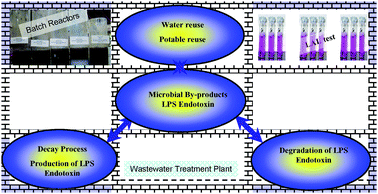Assessment of endotoxin activity in wastewater treatment plants
Abstract
Endotoxic material, commonly associated to biological reactions, is thought to be one of the most important constituents in

* Corresponding authors
a
Environmental Engineering Department, Graduate School of Engineering, Hokkaido University, Kita 13, Nishi 8, Kita-ku, Sapporo, Japan
E-mail:
g_mokh@yahoo.fr, funamizu@eng.hokudai.ac.jp
Fax: +81 117066270
Tel: +81 117066270
b
Laboratoire Eau et Technologies Membranaires, CERTE, Borj Cedria Technopark, BP 273, Soliman, Tunisia
E-mail:
mahmoud.dhahbi@certe.rnrt.tn
Fax: +216 79412802
Tel: +216 71431122
Endotoxic material, commonly associated to biological reactions, is thought to be one of the most important constituents in

 Please wait while we load your content...
Something went wrong. Try again?
Please wait while we load your content...
Something went wrong. Try again?
M. Guizani, M. Dhahbi and N. Funamizu, J. Environ. Monit., 2009, 11, 1421 DOI: 10.1039/B901879D
To request permission to reproduce material from this article, please go to the Copyright Clearance Center request page.
If you are an author contributing to an RSC publication, you do not need to request permission provided correct acknowledgement is given.
If you are the author of this article, you do not need to request permission to reproduce figures and diagrams provided correct acknowledgement is given. If you want to reproduce the whole article in a third-party publication (excluding your thesis/dissertation for which permission is not required) please go to the Copyright Clearance Center request page.
Read more about how to correctly acknowledge RSC content.
 Fetching data from CrossRef.
Fetching data from CrossRef.
This may take some time to load.
Loading related content
